We had some discussions about Poland in the Realms Beyond thread. They're commonly held as a top tier civilization, although like the Shoshone, I don't think I agree. Extra social policies sound awesome... but think about it, exactly where would they go? The elephant in the room is Rationalism, which you pretty much always need. Poland only gets two extra policies before Rationalism opens, which is at best a moderate dip into something like Patronage or Commerce. Poland can fill Rationalism sooner, but so can the likes of Korea or Babylon just by unlocking it earlier. Poland could splash somewhere else after Rationalism, but there's nothing that really looks like it would make a major difference that late.
But here's a path that can work for Poland: Culture victory. It's said that the optimal path for fast tourism is by way of the Sacred Sites reformation policy (+2 tourism per faith building). However, this plan is policy-intensive: you want Tradition as usual, then four policies in Piety up to Reformation, then all of Aesthetics. That takes a while for anyone except Poland, but that looks like the one way to make use of Poland's extra policies other than just pushing them into Rationalism. Poland should be able to cover this plan no problem, and even also have enough for the other two policies to complete Piety as well. (It's a shame how Piety is designed that you need to go through three fairly bad policies to get to Reformation, then the one good policy and finisher are off that track.)
So I will play Poland for culture. I don't think that a bit more speed to these policies will beat out the tourism abilities of Brazil or France. But like the Shoshone game for science, this should set a good baseline for tourism that I can then try to beat with the better options.
This report is of my second try at this setup. In the first, I missed several key wonders and then incurred a war declaration from neighboring Japan that set me back too much. Also, I learned from that game that this plan can buy a Pagoda in every city pretty quickly, so you do want a second follower belief for faith buildings, in Mosques.
After a number of map rolls, I realized you need to Disable Start Bias for some civs such as Poland. You don't want their Plains preference when looking for a cooked Desert Folklore map. This option is legal by CFC HOF rules.
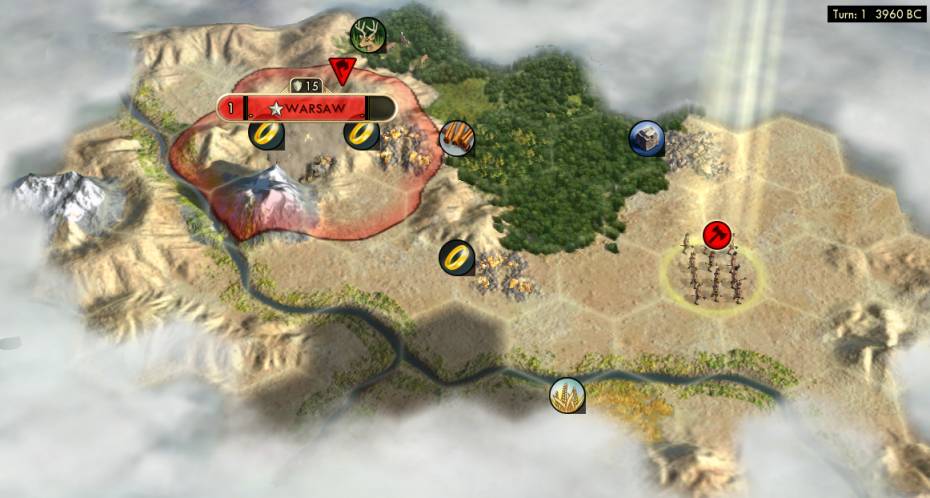
We'll try that. Nice big amount of Petrable hills. And a luxury resource to settle on. Settling on a luxury is big because it's available to sell before you have a worker. In fact, it's a double swing to sell the resource to buy the worker faster, rather than the other way around.
As always, Inland Sea yields easy exploration and a large amount of ancient ruins.

Like that in the southeast corner, popped one ruin for a map to find three more! The AIs often take a long time to get to the edges of the map, and you can find lots of ruins even fairly late.
I got 70 gold, an archer upgrade who stayed around home for defense, 75 gold, Pottery on t11 with one turn to go on the research  , but then Calendar! Turn 14 finally came a culture ruin to start Tradition. Then t18 map, t19 survivors to size two, t21 big faith!, t23 culture again, t25 85 gold.
, but then Calendar! Turn 14 finally came a culture ruin to start Tradition. Then t18 map, t19 survivors to size two, t21 big faith!, t23 culture again, t25 85 gold.
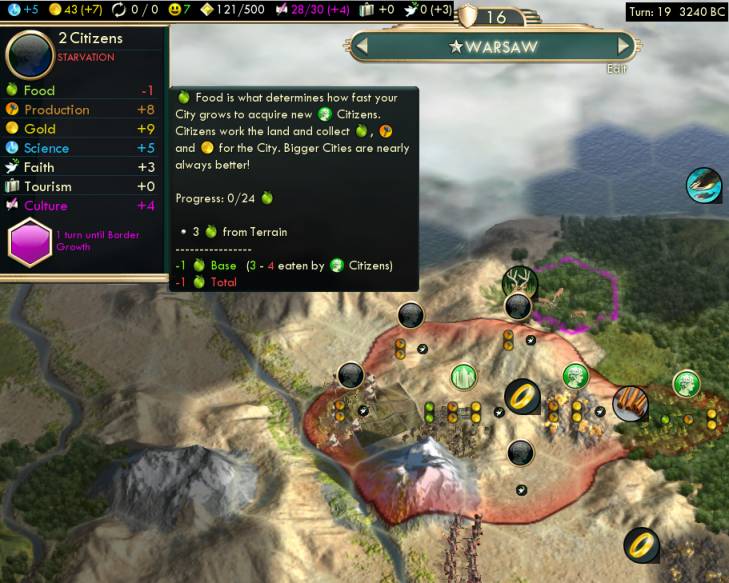
But here's a problem. Those survivors actually STARVED and I couldn't do anything about it! There's not a single way to get one more food to save that citizen. I'm one turn short of culture to claim the deer. And one turn short of money to BUY the deer! If only the culture picker had taken the deer over the spices (both were highlighted equally). Oh well.
More generally, that does highlight a problem with this capital - there's not a single food tile in first ring. It stayed at size 1 until something like turn 25, an insanely long time. But that was actually okay. Growing doesn't actually help until you have tiles to work with better than 2 foodhammer yield. And working the gold from turn 1 helped buy the worker quickly, on turn 15, that's the earliest I've managed in BNW without lump sum resource sales.
Mining was my second tech and finished on t21, making the gold under the city available, but nobody had money to sell it to. Until suddenly William of the Dutch friended me out of nowhere, and paid me his 180 treasury for it! I happily bought a second worker on t29. t33 finally sold the second gold upon meeting Washington for 6/turn. t45 hooked and sold spices.
Build order: scout - scout - scout - shrine - granary (finished t27) - scout - warrior (a ruins-upgraded archer also stayed around for defense) - settler - settler - caravan - Petra. Building the two settlers might have been a mistake, that slowed the capital's growth even more. But I counted on Petra to solve that eventually.
Research order: Pottery - (popped Calendar) - Mining - Bronze Working - Writing (was a mistake, didn't build the library for a while) - Masonry for marble at another city - then up to Currency for Petra.
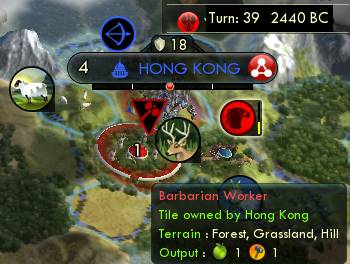 I also got a worker steal, the clean way without actual war, lucked into a barbarian-stolen but unprotected city-state worker.
I also got a worker steal, the clean way without actual war, lucked into a barbarian-stolen but unprotected city-state worker.
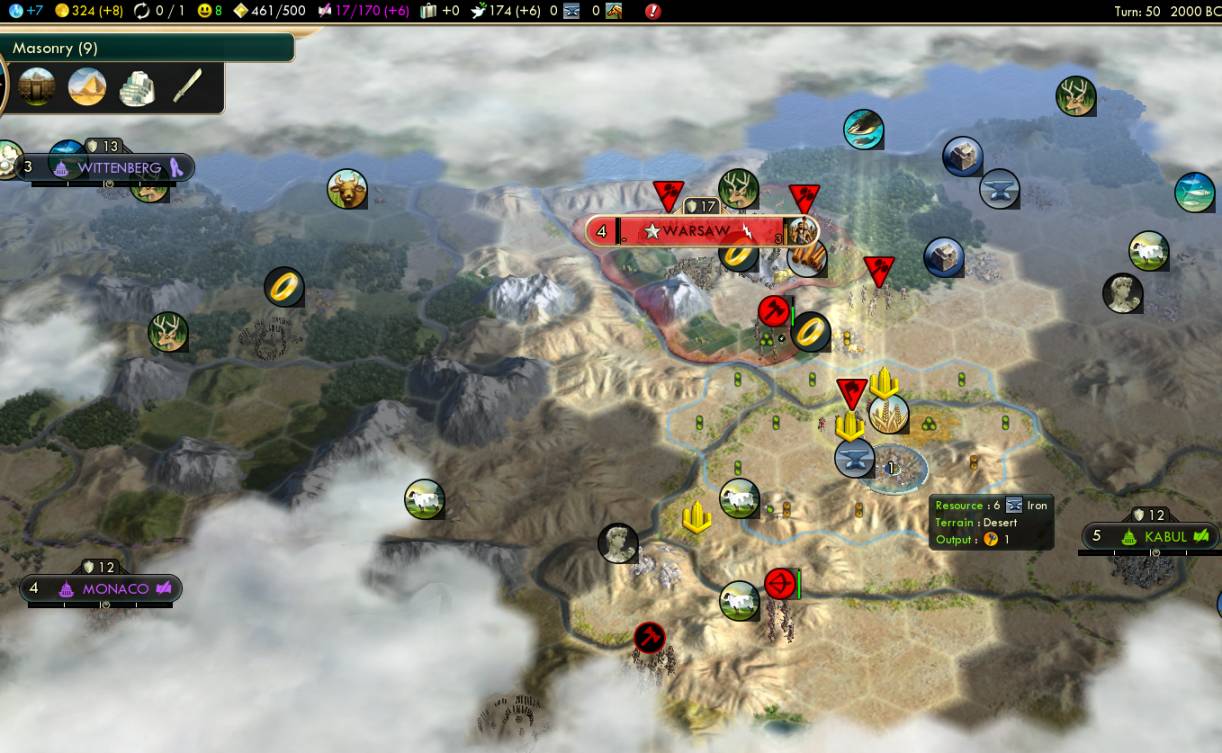
Here's an overview at the founding of city two, somewhat late on turn 50. It's smartly planted on 6 iron to sell immediately. It's off riverside but that's actually fine. Riverside access is not important in a BNW culture game. A science game does want riverside access for the garden for great scientists, and for the hydro plant for spaceship parts. But a culture game needs none of that outside the Guild cities. Watermills are just unnecessary in BNW compared to a food trade route.

Policies: t14 Tradition opener, t21 Oligarchy, t30 Legalism, t48 Landed Elite, t67 Monarchy. Then the finisher on t71 via Solidarity (Poland's ability). Poland can indeed finish Tradition 10-20 turns sooner than other civs, which does have some value.
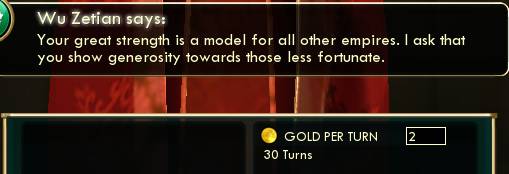
Ha, I think we can afford that. That's about as cheap as you can possibly buy any diplomatic benefit. Between that and retrieving a barb-captured settler for her, China friended me too, very helpful as she continually fed me cash for resource sales and loans.

Religion: I got Desert Folklore early, on turn 19. Religion came a bit on the late side thanks to the underpopulated capital, but turn 57 was good enough. Took Tithe and Pagodas. Pagodas are a better faith building than Mosques; the difference is 1 happy instead of 1 faith, of which the former is more valuable, there's more ways to get faith cheaper.
I wanted to go for the enhancement first in order to wait for the Mandate of Heaven discount before buying anything else, but changed my mind since that first missionary really is that important. He really accounts for something like 5 or 6 spreads, since the capital's pressure alone will never convert anything, but 3 cities worth of pressure will convert your own newly founded cities and usually a city-state or two. Also the missionary would pay back the faith just by way of bringing Desert Folklore to the cities that missed the pantheon. (Still complaining about that mechanic: cities that you build before founding a religion get your pantheon for free, cities built afterwards don't.)
Unfortunately, America got religion and took the Mosques belief, faster than I could have gotten to the enhancement even by skipping the missionary. I had to settle for Cathedrals, not so good but hey we'll actually use some of the artwork slots. Enhancer belief was the usual Religious Texts.
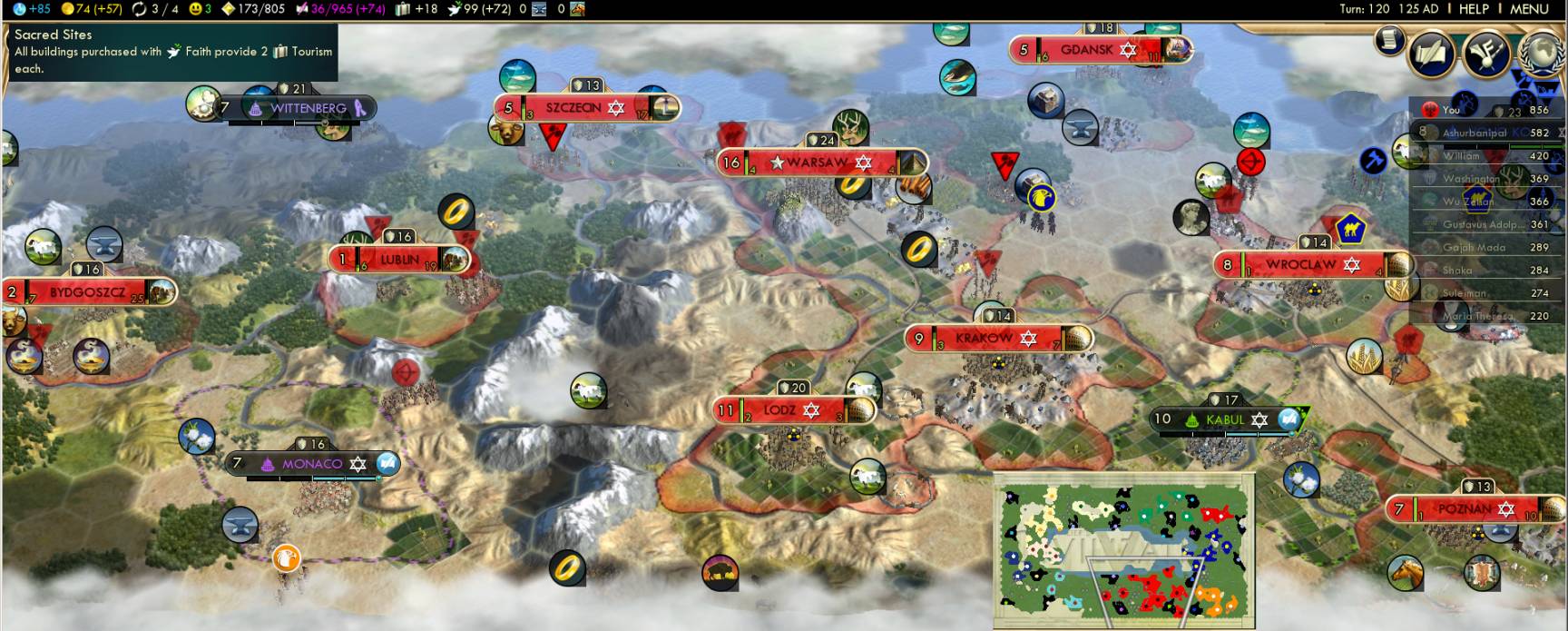
Here's an overview. I expanded out to these nine cities. Wroclaw is a bit awkward in third-ring away from the silver, but I picked this spot because it was carefully one tile closer to my capital than to the neighboring Dutch capital of Amsterdam. So this city didn't anger him, and surprisingly, he also didn't even complain when I bought the silver tile.
After Tradition, the policies went into Piety of course. t87 was the opener, t99 Mandate of Heaven via Solidarity on entering the medieval era, t104 Organized Religion via the Oracle, t107 Religious Tolerance, then t125 the Reformation policy and belief.
So Poland got from Tradition to Sacred Sites ~30 turns before anyone else could. I have 7 Pagodas and 2 Cathedrals in place (the western two cities didn't get the religion yet), so there's 18 tourism already. And you can also see that +72 faith production which would continue to rise quickly with more desert tiles and faith buildings. I was soon buying Pagodas and Cathedrals at less than two turns each.
With the Sacred Sites tourism active, I signed Open Borders all around. I had suspected this would happen and it was true: the price for Open Borders went WAY up after the tourism kicked in, up to 15 gpt from some civilizations! So I reloaded from before taking the policy and bought the OB deals at normal price instead. (This is why I don't play for the CFC HOF, I'm not going to risk an entire game being invalidated on one silly oversight and reload like that.)
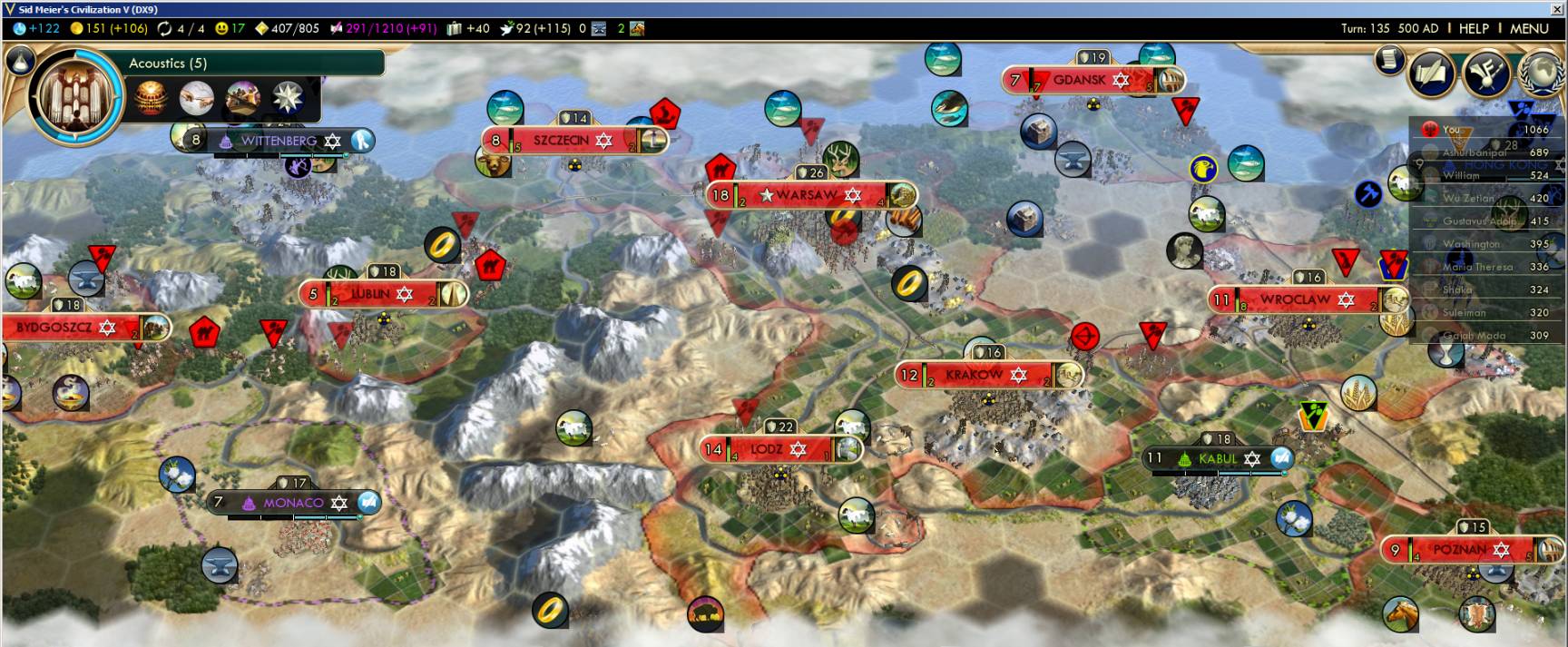
Just another 15 turns after the previous picture, I had completed all 18 faith buildings. Looks like more ICS might indeed be the way to go for this plan. I think that across all the Civilization games, whenever ICS is recommended as a strategy, it's actually somewhat overblown and you do better by tempering the approach at least a bit into putting some heed into the quality of city sites. But for Sacred Sites, maybe you do need as many cities as you can fit.
All this setup for Sacred Sites went FAST. See 115 faith/turn in that picture, that's a pagoda or cathedral every 1.5 turns! All those faith buildings came before we even got around to the Great Mosque. (It also turns out that the free Mosque from that wonder does count for Sacred Sites as well.) I never got to Borobudur, there was no need, as the faith buildings all finished so the faith just spilled over into normal missionary production instead.
Happiness was tight, but barely manageable. I had to set avoid growth on several cities for several turns. But then suddenly, the cap lifted. I completed a wave of several colosseums, and also triggered a few mercantile city-states into cascading resource quests into each other. I found myself with a surprising 22 happiness, so that was the headroom to go cram in more cities.
Tech: Acoustics was the important goal, for the Musicians' Guild, and Sistine to eke out a few policies a bit sooner. I had a Great Engineer from the early wonders that saved for Uffizi, and a Great Scientist that bulbed up to Archaeology, although the only thing that did was get another Poland policy, the game ended before we built any archaeologists. I produced two Great Musicians, who went to the two strong opposing culture producers in Sweden and Netherlands, both nearby.
Policies: After the Reformation, as unaesthetic as it was to leave Piety unfinished (without Theocracy), it's really not going to do much of anything and we needed Aesthetics more. I continued into that tree, with the Solidarity policies for the renaissance and industrial eras going there. Reached Cultural Exchange on t167 and Artistic Genius via Solidarity on t170...
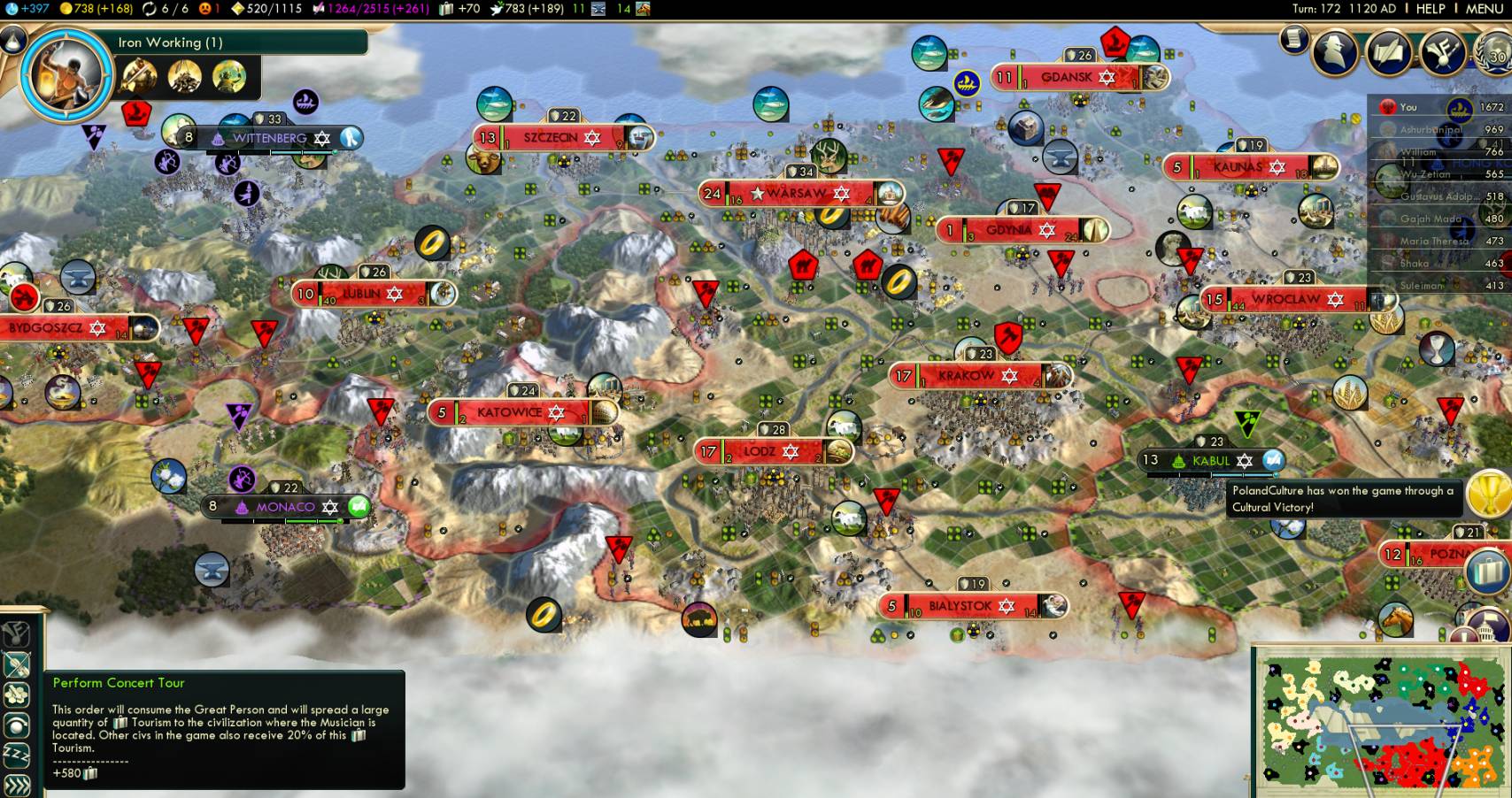
... and we just won. Culture Victory on turn 173 1130 AD.
Yeah, Sacred Sites is that good. 60 base tourism along with the usual multipliers did indeed just overwhelm the AI culture production by the late renaissance. I don't really have much insight into the numbers, it just happened, it outraced the AIs from the moment I got the policy.
It's effective because Pagodas are very good on their own. I'd kind of forgotten this after my experiences in G&K. Why buy a faith building over a missionary, when the missionary gives the same 2 happy via Ceremonial Burial and also snowballs into more pressure for more conversions? But with CB nerfed in BNW, Pagodas really are a strong source of happiness. In fact, check this out: Pagodas virtually convert one faith as equal to one hammer. A Pagoda costs 160 faith with Mandate of Heaven and actually produces exactly 160 hammers worth of value. The 2 happy is like a 100H colosseum; the 2 culture is like a 40H monument, and the 2 faith is like a Piety-policy-powered 20H shrine. Total 160 hammers. Pagodas are almost like a half-Petra that applies to every single desert tile for free.
As fast as that was, I can indeed see several ways to improve on this time. Which will come in another report.